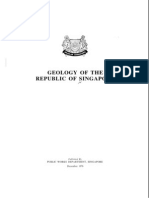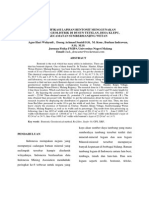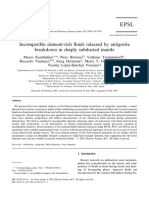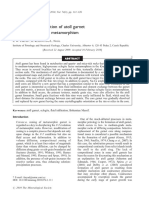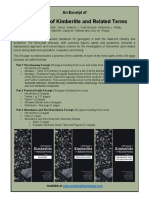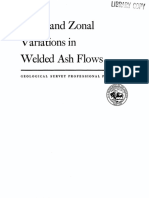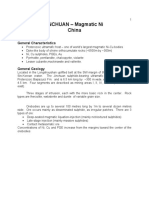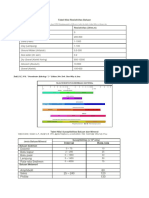Scientic Research AbstractsVol. 7, p. 808, 2017ISSN 2464-9147 (Online)XVI International Clay Conference | ICC 2017 | Granada, Spain© Author(s) 2017. CC Attribution 3.0 License
MICA-VERMICULITE INTERGROWTH EXPANSION THROUGH NATURAL PROCESSES IN PYROCLASTIC CARBONATITES FROMCATANDA (ANGOLA)
j
inGyao
x
u
(1)*, m
arC
C
ampeny
(1), e
sperança
t
auler
(1), j
oan
C
arles
m
elGarejo
(1), a
ntonio
o
limpio
G
onçalves
(2)
(1) Departament de Mineralogia, Petrologia i Geologia Aplicada, Facultat de Geologia, Universitat de Barcelona, 08028 Barcelona, Spain, (2) Departamento de Geologia, Universidade Agostinho Neto, Luanda, Angola
*jingyao.xu@ub.edu
Catanda carbonatites are found in the Kwanza Sul province, about 350 km SE of Luanda (Angola). Theseare formed by small volcanic cones consisting of a series of pyroclastic rocks with minor interbedded carbonatitic lavas [1]. Phlogopite as a carbonatitic mineral and annite as xenocrystal provided from hosted granites are found in the Catanda pyroclastic carbonatites. Secondary minerals such as vermiculite have also been reported [1].Under petrographic study, phlogopite and annite present textures as non-expanded, slightly expanded and strongly expanded dening accordion texture. Vermiculite can be distinguished using SEM-EDS in back-scattered electron (BSE) mode. Bothphlogopite and annite are affected by the vermiculitization process. Previous work [2,3] has proposed that vermiculitization of micas proceeds through the sequence: mica to inter
-
stratied mica-vermiculite to vermiculite, and this is determined byXRD as peaks at 10, 12 and14 Å, respectively. In the present study of the Catanda samples, diffraction peaks were identied at 10 and 14 Å only, and no 12 Åpeak was found. We propose that the Catanda intermediate product of phlogopite-vermiculiteshould not be considered as an interstratied phlogopite-vermiculite but a mixture of phlogopite and vermiculite, consisting of intergrowths of both minerals inan intermediate stage of alteration, similar to theintergrowth of phyllosilicates described inother works [4,5]. By EMP analysis, vermiculite generated by the alteration of phlogopite is dominated by Ca in the
interlayer position, it has d
002
values of 14.6-14.8 Å identied by XRD, so the alteration of phlogopite produced Ca-vermiculte. For the alteration of annite, all analysis shows Mg <0.5 and K
2
O contents of >5 wt.%. We propose that annite altered to K-vermiculite which has d
002
spacing of 10.42 Å, so the intermediate product between annite and K-vermiculite has d
002
about 10 Å. The d
002
spacing of 10.07 Å corresponds to annite and phlogopite, also could be K-vermiculite, so as intergrowth or interstratied annite and K-vermiculite. Pure vermiculites have little ability to expand but do increase in polyphase intergrowths, which are denedas intra-particle mosaics between mica and vermiculite, a rapid heating (>300 °C) may generate theexpansion of mi
-
ca-vermiculite intergrowths [4]. We propose that the formation of the accordions texture as product of expansion is related to the rapid heating caused by the volcanic process that occurred in the Catanda area [1]. The intergrowth vermiculite-phlogopite stimulated the expansion. To the authors’ knowledge, this is the rst report of the accordion texture related to the vermiculite expansion occurring under natural conditions.
[1] Campeny M., Mangas J., Melgarejo J.C., Bambi A., Alfonso P., Gernon T., Manuel J. (2014). The Catanda extrusive carbonatites (Kwanza Sul, Angola): an example of explosive carbonatitic volcanism. Bulletin of Volcanology, 76, 818-834.[2] Moon H.S., Song Y., Lee S.Y. (1994). Supergene vermiculitization of phlogopite and biotite in ultramac and mac rocks, Central Korea. Clays and Clay Minerals, 42, 259-268.[3] Azzone R.G., Ruberti E. (2010). Evolução Composicional dos Filossilicatos no Perl Intempérico do Complexo Ultramáco Alcalinocar
-
bonatítico de Catalão I (GO). Geologia USP, SérieCientíca, 10, 23-43. Minerals, 42, 259-268.[4] Hillier S., Marwa E.M.M., Rice M. (2013). On the mechanism of exfoliation of “vermiculite”. Clay Minerals, 48, 563-582.[5] Giorgetti G., Memmi I., Nieto F. (1997). Microstructures of intergrown phyllosilicate grains from Verrucanometasediments (northern Apennines, Italy). Contributions to Mineralogy and Petrology, 128, 127-138.
View publication statsView publication stats

